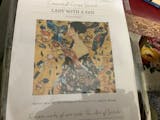G.D. Leslie (2)
George Dunlop Leslie (1835–1921) was a British genre and portrait painter, best known for his depictions of domestic scenes and his sensitive portrayals of women and children. He was part of the Victorian era's artistic establishment and a leading member of the Royal Academy. Leslie’s works are celebrated for their charm, warmth, and ability to capture the beauty in everyday life.
Leslie is particularly known for his genre paintings — works that depict scenes from everyday life. His paintings often show women and children engaged in domestic activities, offering a glimpse into Victorian society and its values. His works include scenes of reading, sewing, and family life, such as "The Reading Lesson" (1875) and "The Young Wife" (1863).
Many of Leslie’s paintings feature women in tender, intimate settings. He was especially adept at capturing the delicacy and grace of female subjects. His portrayal of women often emphasizes their roles as caregivers and nurturers within the family, reflecting the idealized view of Victorian womanhood.
While Leslie’s work was immensely popular during his lifetime, his reputation waned somewhat in the 20th century as tastes shifted toward modernism. However, his paintings have been rediscovered in recent years, with exhibitions and retrospectives highlighting his mastery in capturing the quiet elegance of Victorian life.









